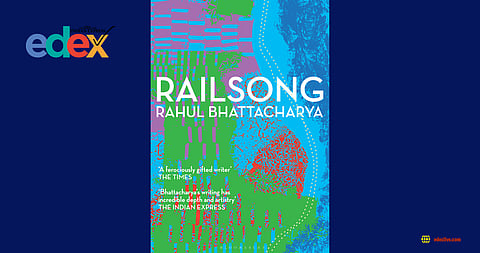

For Charulata Chitol, yearning was constant. She wanted “to become something”. A self-willed girl who lost her mother early, she grew up with her two brothers under the care of a stern railway foreman father devoted to his work. Set in the post-Independence years, Rahul Bhattacharya’s Railsong (Bloomsbury) traces her life from the railway township of her childhood in the 1960s to the late 1990s, against the backdrop of a nation in motion as steam engines gave way to diesel and India moved through the railway strike and the Emergency of the 1970s.
Nearly a decade after his first novel, The Sly Company of People Who Care (2011), Bhattacharya returns with Railsong. “I wanted to write a novel around an enterprise that gestures at the gargantuan scale and complexity of our country – such as the census, or the railways – with an individual in the middle of it,” Bhattacharya says. “I needed to discover the individual. And that process became the novel.”
Bhattacharya considered calling the novel Song of the Rail — a nod to Pather Panchali (Song of the Road) — but named it Railsong to capture the musical rhythm of its world. “It evokes the sound of a train on its tracks, familiar to travellers and to anyone who lives or works by the railway lines,” Bhattacharya says, “but also conjures the idea of the network running like a song through the soul of our country.”
For Bhattacharya, the railways — what Jawaharlal Nehru once called “our greatest national undertaking” — serve as both setting and metaphor, a “human network” through which the story of Charu and of India unfolds. “The locomotion, and the commotion, of Charu’s life drive us through this web of connected lives,” he says.
Personal meets the political
Charu’s family, the Chitols, are an anomaly from the start. Her father, Animesh Kumar Chattopadhyay, a railway employee, renounced his surname — and with it, the mark of his Brahmin caste — when he married Jigayasa, a woman from Bihar “outside community, caste, and colour” as described in the book. She teasingly called her husband ‘Mr Chitol’, after the beloved Bengali fish.
Written in the third person, Railsong views the world through Charu’s eyes — her questions, confusions, and defiance — moving through the everyday politics of caste, class, gender, and labour. In one scene, Charu finds herself in conversation with a fellow train passenger — a woman determined to decode the family’s origins. “Bengali? Bihari?” she presses, before giving up in exasperation. Bhattacharya sees politics “as the idea of how one lives among others”.
The novel also shows how the personal and the political constantly intermingle. “In photographs and films, I like oblique vantage points. I found it exciting to look at bigger events from Charu’s angle,” says Bhattacharya. The 1974 railway strike, for instance, was not just a national rupture but a turning point in Charu’s life, forcing her family to leave their township in Bhombalpur. “It precipitates an action that has a significant bearing on the course of the novel,” he adds.
Building Charu’s world
Male authors writing female characters often flatten the women into fragile figures with little agency beyond serving a male protagonist’s arc. But Bhattacharya’s Charu feels fully alive — funny, flawed and believable — a character who rebels and observes with humour, capturing the innocence and rebellion of girlhood.
In one chapter, when she gets her first period, she awaits death, believing she has sinned by sneaking out one evening with her friend Salima; in another, she puzzles over her grandmother’s insistence on bathing immediately after using the restroom “to become pure”, or argues with her father wanting to take part in the Railway protests.
Bhattacharya says writing from Charu’s perspective — a woman navigating patriarchy, poverty, and possibility — was both an artistic and moral challenge, admitting that writing across gender demanded conscious unlearning. “I had to slowly feel my way through areas unfamiliar to the male experience,” he says.
Charu’s restlessness to live on her own terms — though set in the 1960s, feels startlingly modern, echoing the dreams of many women today. “I’m always struck by how contemporary and universal the enduring works of literature are showing how timeless human impulses are. An individual’s quest for freedom is timeless,” Bhattacharya reflects. “Charu’s yearning to escape domesticity is the visible tip of the iceberg, but there’s something more existential beneath — her working out a way to be in the world.”
If the railway township feels like a miniature India — equal parts progress and alienation — that was deliberate too. “To Charu’s father, the township represents a progressive vision – a ‘scientific temper’; to her grandmother it is culturally alienating, removed from kith and kin, from more traditional caste- or language-based networks.”
(By Aditi Reena Ajith of The New Indian Express)
